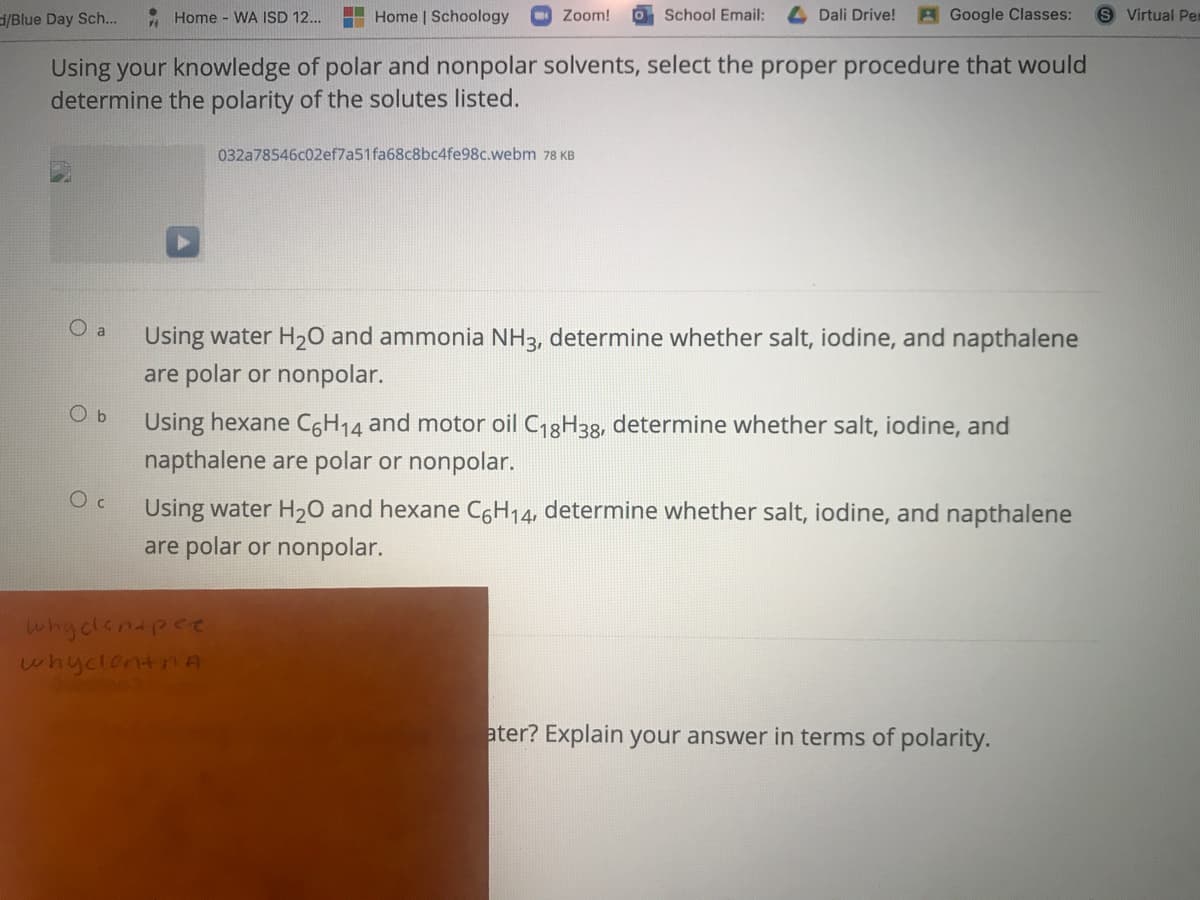Using your knowledge of polar and nonpolar solvents, select the proper procedure that would determine the polarity of the solutes listed. 032a78546c02ef7a51fa68c8bc4fe98c.webm 78 KB O a Using water H20 and ammonia NH3, determine whether salt, iodine, and napthalene are polar or nonpolar. Using hexane C6H14 and motor oil C18H38, determine whether salt, iodine, and napthalene are polar or nonpolar. O c Using water H20 and hexane C6H14, determine whether salt, iodine, and napthalene are polar or nonpolar.
Using your knowledge of polar and nonpolar solvents, select the proper procedure that would determine the polarity of the solutes listed. 032a78546c02ef7a51fa68c8bc4fe98c.webm 78 KB O a Using water H20 and ammonia NH3, determine whether salt, iodine, and napthalene are polar or nonpolar. Using hexane C6H14 and motor oil C18H38, determine whether salt, iodine, and napthalene are polar or nonpolar. O c Using water H20 and hexane C6H14, determine whether salt, iodine, and napthalene are polar or nonpolar.
Chemistry: Principles and Reactions
8th Edition
ISBN:9781305079373
Author:William L. Masterton, Cecile N. Hurley
Publisher:William L. Masterton, Cecile N. Hurley
Chapter10: Solutions
Section: Chapter Questions
Problem 66QAP: The Henry's law constant for the solubility of radon in water at is 9.57106 M/mm Hg. Radon is...
Related questions
Question
I need help please
(Not honor class)
(Not grading)

Transcribed Image Text:/Blue Day Sch..
A Home - WA ISD 12...
Home | Schoology
Zoom!
O School Email:
Dali Drive!
BGoogle Classes:
Virtual Per
Using your knowledge of polar and nonpolar solvents, select the proper procedure that would
determine the polarity of the solutes listed.
032a78546c02ef7a51fa68c8bc4fe98c.webm 78 KB
O a
Using water H20 and ammonia NH3, determine whether salt, iodine, and napthalene
are polar or nonpolar.
O b
Using hexane C6H14 and motor oil C18H33, determine whether salt, iodine, and
napthalene are polar or nonpolar.
Using water H20 and hexane CGH14, determine whether salt, iodine, and napthalene
are polar or nonpolar.
whydlenapee
whyclentnA
ater? Explain your answer in terms of polarity.
Expert Solution
This question has been solved!
Explore an expertly crafted, step-by-step solution for a thorough understanding of key concepts.
This is a popular solution!
Trending now
This is a popular solution!
Step by step
Solved in 2 steps

Knowledge Booster
Learn more about
Need a deep-dive on the concept behind this application? Look no further. Learn more about this topic, chemistry and related others by exploring similar questions and additional content below.Recommended textbooks for you

Chemistry: Principles and Reactions
Chemistry
ISBN:
9781305079373
Author:
William L. Masterton, Cecile N. Hurley
Publisher:
Cengage Learning

Chemistry & Chemical Reactivity
Chemistry
ISBN:
9781337399074
Author:
John C. Kotz, Paul M. Treichel, John Townsend, David Treichel
Publisher:
Cengage Learning

Chemistry & Chemical Reactivity
Chemistry
ISBN:
9781133949640
Author:
John C. Kotz, Paul M. Treichel, John Townsend, David Treichel
Publisher:
Cengage Learning

Chemistry: Principles and Reactions
Chemistry
ISBN:
9781305079373
Author:
William L. Masterton, Cecile N. Hurley
Publisher:
Cengage Learning

Chemistry & Chemical Reactivity
Chemistry
ISBN:
9781337399074
Author:
John C. Kotz, Paul M. Treichel, John Townsend, David Treichel
Publisher:
Cengage Learning

Chemistry & Chemical Reactivity
Chemistry
ISBN:
9781133949640
Author:
John C. Kotz, Paul M. Treichel, John Townsend, David Treichel
Publisher:
Cengage Learning

Chemistry: The Molecular Science
Chemistry
ISBN:
9781285199047
Author:
John W. Moore, Conrad L. Stanitski
Publisher:
Cengage Learning

Chemistry: An Atoms First Approach
Chemistry
ISBN:
9781305079243
Author:
Steven S. Zumdahl, Susan A. Zumdahl
Publisher:
Cengage Learning

Introductory Chemistry: A Foundation
Chemistry
ISBN:
9781337399425
Author:
Steven S. Zumdahl, Donald J. DeCoste
Publisher:
Cengage Learning